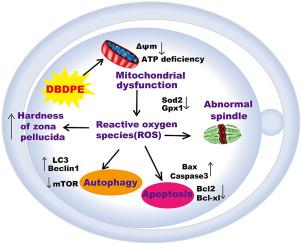Ecotoxicology and Environmental Safety ( IF 6.2 ) Pub Date : 2020-09-15 , DOI: 10.1016/j.ecoenv.2020.111290 Feifei Shi 1 , Jinyu Qiu 2 , Jingwen Zhang 1 , Sijie Wang 1 , Xin Zhao 2 , Xizeng Feng 1

|
Decabromodiphenyl ethane (DBDPE), a widely used new brominated flame retardant, is added into flammable materials to achieve fire retardation. As it is continuously detected in the environment, it has become an emerging environmental pollutant. However, the effects of DBDPE exposure on oocyte maturation and its underlying mechanisms remain unknown. This study found that DBDPE exposure inhibited the rate of germinal vesicle breakdown (GVBD), first polar body extrusion (PBE) and fertilization of mouse oocytes. After 14 h of exposure to DBDPE, metaphase II (MII) oocytes showed that the hardness of zona pellucida (ZP) markedly increased and that the spindle morphology was abnormal. Moreover, DBDPE exposure induced abnormal mitochondrial distribution, mitochondrial dysfunction, and ATP deficiency. Simultaneously, DBDPE exposure down-regulated the expression of antioxidant-related genes (Sod2, Gpx1) and increased the level of reactive oxygen species (ROS) in oocytes. The results of immunofluorescence and qRT-PCR revealed that autophagy occurred in DBDPE-treated oocytes with high expression of autophagy-related protein (LC3) and genes (Lc3, Beclin1). Meanwhile, DBDPE significantly up-regulated the protein (Bax) and mRNA (Bax, Caspase3) levels of pro-apoptosis genes. However, the protein and mRNA expression of anti-apoptosis genes Bcl-2 was dramatically down-regulated in DBDPE-exposed oocytes. Collectively, DBDPE exposure impaired mitochondrial function, causing oxidative damage, autophagy and apoptosis in oocytes.
中文翻译:

十溴二苯乙烷对小鼠卵母细胞的毒性作用及其可能的机制。
十溴二苯乙烷(DBDPE)是一种广泛使用的新型溴化阻燃剂,已添加到易燃材料中以实现阻燃。随着在环境中不断检测到它,它已成为一种新兴的环境污染物。但是,DBDPE暴露对卵母细胞成熟的影响及其潜在机制仍然未知。这项研究发现,DBDPE暴露抑制了生胚囊泡分解(GVBD),第一极体挤出(PBE)和小鼠卵母细胞受精的速度。暴露于DBDPE 14 h后,中期II(MII)卵母细胞显示透明带(ZP)的硬度明显增加,纺锤体形态异常。此外,DBDPE暴露会引起线粒体分布异常,线粒体功能障碍和ATP缺乏。同时,Sod2和Gpx1)并增加卵母细胞中的活性氧(ROS)水平。免疫荧光和qRT-PCR的结果表明,自噬发生在DBDPE处理的卵母细胞中,自噬相关蛋白(LC3)和基因(Lc3,Beclin1)的表达高。同时,DBDPE显着上调了促凋亡基因的蛋白质(Bax)和mRNA(Bax,Caspase3)水平。然而,抗凋亡基因Bcl-2的蛋白质和mRNA表达在暴露于DBDPE的卵母细胞中显着下调。总体而言,DBDPE暴露会损害线粒体功能,导致卵母细胞氧化损伤,自噬和细胞凋亡。











































 京公网安备 11010802027423号
京公网安备 11010802027423号